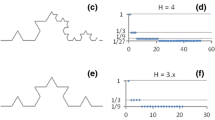Abstract
As other spheres of image analysis, fractography has no universal method for information convolution. An effective characteristic of an image is found by analyzing the essence and origin of every class of objects. As follows from the geometric definition of a fractal curve, its projection onto any straight line covers a certain segment many times; therefore, neither a time series (one-valued function of time) nor an image (one-valued function of plane) can be a fractal. For applications, multidimensional multiscale characteristics of an image are necessary. “Full” wavelet series break the law of conservation of information.
Similar content being viewed by others
References
A. B. Merkov, Image Recognition. Introduction to Statistical Educaiton Methods (Editorial URSS, Moscow, 2011).
N. N. Krasil’nikov, Digital Image Processing (Vyuzovskaya Kniga, 2001).
A. S. Viktorov, Landscape Picture (Mysl’, Moscow, 1986).
Yu. A. Krupin and V. G. Sukhova, Computer Metallography (ID MISiS, Moscow, 2009).
A. S. Mel’nichenko, Statistical Analysis in Metallurgy and Materials Science (ID MISiS, Moscow, 2009).
Digital Image Transformation, Ed. by R. E. Bykov (Goryachaya Liniya-Telekom, Moscow, 2003).
Yu. L. Klimontovich, Introduction to the Physics of Open Systems (Yanus-K, Moscow, 2002).
B. Mandelbrot, Fractal Geometry of Nature (IKI, Moscow, 2002).
Physical Encyclopedia, Ed. by A. M. Prokhorov (BRE, Moscow, 1998), Vol. 5, p. 371.
Probability and Mathematical Statistics. Encyclopedia, Ed. by Yu. V. Prokhorov (BRE, Moscow, 1999), p. 777.
M. Shreder, Fractals, Chaos, Power Laws (RKhD, Moscow, 2001).
O. I. Shelukhin, A. M. Tenyakshev, and A. V. Osin, Fractal Processes in Telecommunications (Radiotekhnika, Moscow, 2003).
M. A. Shtremel’, “Generalization of the Pareto distribution in statistical metallography problems,” Zavod. Lab. 71 (8), 25–31 (2005).
D. Yu. Ivanov, Critical Behavior of Nonidealized Systems (Fizmatlit, Moscow, 2003).
A. N. Pavlov and V. S. Anishchenko, “Multifractal analysis of complex signals,” Usp. Fiz. Nauk 177 (8), 859–876 (2007).
F. Mun, Chaotic Oscillations (Mir, Moscow, 1990).
R. M. Rangaiyan, Analysis of Biomedical Signals. Practical Approach (Fizmatlit, Moscow, 2007).
A. A. Potapov, Fractals in Radiophysics and Radiolocation: Topology of Sample (Universitetskaya Kniga, Moscow, 2005).
G. A. Kukharev, Biometric Systems. Methods and Means of Identification of Personality (Politekhnika, St. Petersburg, 2001).
B. Yane, Digital Image Processing (Tekhnosfera, Moscow, 2007).
Novel Image Processing Methods, Ed. by A. A. Potapov (Fizmatlit, Moscow, 2008).
A. S. Potapov, Image Recognition and Machine Perception. General Approach Based on the Principle of the Minimum Description Length (Politekhnika, St. Petersburg, 2007).
D. Forsait and Zh. Pons, Computer Vision. Modern Approach (Vil’yams, Moscow, 2004).
A. A. Koronovskii and A. E. Khramov, Continuous Wavelet Analysis and Its Applications (Fizmatlit, Moscow, 2003).
A. A. Bol’shakov and R. N. Karimov, Methods of Processing of Multidimensional Data and Time Series (Goryachaya Liniya-Telekom, Moscow, 2007).
S. Welsteed, Fractals and Wavelets for Image Compression in Action (Triumf, Moscow, 2003).
K. Blatter, Wavelet Analysis. Fundamentals of Theory (Tekhnosfera, Moscow, 2006).
V. P. D’yakonov, Mathcad 11/12/13 in Mathematics: AHandbook (Goryachaya Liniya-Telekom, Moscow, 2007).
N. P. Klepikov and S. N. Sokolov, Analysis and Planning of Experiments Using the Method of Maximum Likelihood (Nauka, Moscow, 1964).
A. A. Greshilov, Incorrect Problems of Digital Processing of Information and Signals (Radio Svyaz’, Moscow, 1984).
A. N. Tikhonov and M. V. Ufimtsev, Statistical Processing of Experimental Results (MGU, Moscow, 1988).
V. Yu. Trebizh, Analysis of Time Series in Astrophysics (Nauka, Moscow, 1992).
V. Yu. Trebizh, Introduction to the Statistical Theory of Inverse Problems (Fizmatlit, Moscow, 2005).
M. A. Shtremel’, “Boundaries of the possibilities of diffractometer analysis of a fine structure,” Dokl. Akad. Nauk SSSR 203, 570 (1972).
V. V. Ovchinnikov, Mössbauer Methods of Analysis of the Atomic and Magnetic Structure of Alloys (Fizmatlit, Moscow, 2002).
I. D. Grachev, M. Kh. Salakhov, and I. S. Fishman, Statistical Regularization during Processing of Experimental Data in Applied Spectroscopy (KGU, Kazan, 1986).
M. A. Shtremel’ and D. A. Kozlov, “On criteria and plans of optimum X-ray diffraction measurement of texture,” Zavod. Lab., No. 5, 15–21 (1991).
K. Chui, Introduction to Wavelets (Mir, Moscow, 2001).
A. S. Monin and D. M. Sonechkin, Climate Oscillations according to Observation Data: Ternary Solar and Other Cycles (Nauka, Moscow, 2005).
G. A. Sobolev and A. V. Ponomarev, Physics of Earthquakes and Precursors (Nauka, Moscow, 2003).
J. C. Russ, Fractal Surfaces (Plenum, New York, 1994).
V. S. Sizikov, Mathematical Methods of Processing Measurement Results (Politekhnika, St. Petersburg, 2001).
E. Terner, I. Kerube, and J. Wilson, Biosensors: Fundamentals and Applications (Mir, Moscow, 1992).
Author information
Authors and Affiliations
Corresponding author
Additional information
Original Russian Text © M.A. Shtremel’, 2014, published in Deformatsiya i Razrushenie Materialov, 2014, No. 10, pp. 2–9.
Rights and permissions
About this article
Cite this article
Shtremel’, M.A. On image analysis in fractography (Methodological Notes). Russ. Metall. 2015, 771–777 (2015). https://doi.org/10.1134/S0036029515100158
Received:
Published:
Issue Date:
DOI: https://doi.org/10.1134/S0036029515100158




